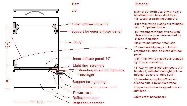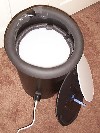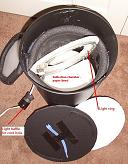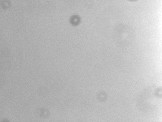Prototype: A Trash Can Light Box for Making Astrophotography White Flats
Rev. Dec. 10, 2005 - K. Fisher fisherka@csolutions.net
Discussion
Often it is not possible to make an astrophotography white-flat using the twilight sky. A white-light box is a convenient aid for making such flats. Berry and Burnell (2005) suggest a wood and foam board design for a light box. No plans were provided. Berry and Burnell at page 126. I tried the following plastic and glue knock-off of a variation on Berry and Burnell's design. Schematics and notes are posted here for reference by other amateur astrophotographers. Since initial posting of the trash can light box, other amateurs forwarded links to the following alternative designs which are superior to the design shown here:
In use, the 3 1/2 lb. round trash can light box is placed over the aperature of 10" Newtonian telescope with a tube outer diameter of 12". An optional rubber compression ring can accomodate smaller aperatures. A 125V AC flexible rope light, available at most chain hardware stores provides illumination. Since this author has a pre-existing 125V AC-12V DC inverter coupled with car battery for powering a telescope mount, no attempt was made at building a more-complicated low-voltage version. White-flats can be made as needed. Light-baffling makes the unit suitable for making white-flats in a group astrophotography setting.
This design differs from the Berry and Burnell light box in that it has two diffuser plates. The Berry and Burnell design has one diffuser plate. The key component of the Berry-Burnell design is a baffled-rear-ward light source that projects into a reflective chamber. This assures a uniform shadowless light. Another key material are milk white plastic diffuser plates. The milk-white plastic plates shown here cost $22US, including cutting-costs, and can purchased from companies in the telephone book under the category "Plastics - Rods, Tubes, Sheets, Etc." Materials costs for this prototype came in at around $75US (trash can $15; rope light $15; milk plastic $22; glue, weatherstripping and pipe insulation $13; foam board and artist paper $10).
After construction, it was apparent that the white light field on the outer diffuser plate was not exactly uniform. A slight variation could be seen with the naked-eye at the outer 2" inches of a 12" diffuser plate. However, the small paraxial area that would be principally exposed by the CCD chip appeared uniform. On testing with a Meade-DSI with the IR filter in place and with a 10" 1200mm fl Newtonian, the test white-flats showed a dispersion of approximately 260 ADU on a well exposure of approximately 14000 ADU after approx. 2 seconds, or a 1.8% variation, per AutoStar Envisage software generated data. A spectrum and Johnson BVRI filter exposures were not made using the rope-light illumination source in order to assess what effect making white-flats using this light source would have on amateur photometry. Test flats without the IR filter were not made.
A very rough measurement of this design's luminance using an old analogue light meter for photography (Capital CDS light meter) was done. The Capital meter is intended to read reflected light down to about 2 or 3 EV. When using this meter during twilight, I can reliably read down to EV1-EV2, usually about 5-10 minutes before nautical twlight. At or just after nautical twlight, the Capital CDS meter can be pegged by putting a finger over the sensor. The meter just raises off the peg during nautical twilight.
The light meter has a very similar response when held 6 inches above the outer diffuse panel of my design. So, I estimate the luminance of my unit between EV0 and EV1. Per tables by Ken Rockwell and others, this yields:
| EV | Lux | Footcandles |
| 0 | 0.23 | 2.5 |
| 1 | 0.46 | 5.0 |
Problems developed with the adherence of the Type II clear silicone RTG glue used to affix supports inside the plastic trash can. The inner ring support should be reinforced with black plastic nylon ties strung through holes to the outside of the trash can. Similarly, the tube or "rope" light also is affixed to the foam board light ring using a combination of small screws, washers and nylon ties.
A smaller version of the trash can light box is suggested using only one-diffuser plate and a reflective cowling that is closer to the original Berry and Burnell design. A key difference over this initial prototype is the use of a reflective cowling or baffle around the doughnut-hole of the light-ring. Similar baffles were part of the original Berry-Burnell design.
Figures 10 and 11 show the effect of rotating the built-in Meade DSI IR filter 180 degrees in two exposures taken within a few minutes apart. In each exposure, the CCD chip is in the same orientation, but the filter is rotated. These figures illustrate why white flats should be made for all filters used during a session with the filters locked into position in a filter wheel. That assures that the dust particles on the filters and micro-variations in filter density, that are responsible for the variations seen in the white flats here, remain in the same orientation with respect to the CCD chip during exposure.
If light interference with other astrophotographers is not a concern, one advanced astrophotographer suggested the following low-tech solution: Use a 24"x36" piece of white foam artist board. Illuminate the board with a single bulb from a cord of Christmas tree lights. Make the white flats at the end of the session by tilting the scope down near horizontal.
Conclusions
After building this prototype model, I concluded the trash-can knock-off was a just-useable light-box design, but that a low-voltage version of Berry and Burnell light-box is the better way to go.
References
- Berry, Richard and Burnell, James. 2005 (2d). Handbook of Astronomical Image Processing. Willman-Bell. << http://www.willbell.com/AIP/Index.htm accessed 11/2005 >>
- Flexilight. Nov. 2005. Ropelight homepage. << http://www.ropelight.net/ accessed 11/2005 >>
- Parker, Fred. 2005. EV Tables (Webpage). << http://www.fredparker.com/ultexp1.htm#evfclux accessed 12/2005 >>
- Rockwell, Ken. 2005. EV Tables (Webpage). << http://www.kenrockwell.com/tech/ev.htm accessed 12/2005 >>
- Sullivan, Dick. 2005. EV Tables (Webpage). << http://home.pcisys.net/~rlsnpjs/minolta/ev%20lv%20asa.html accessed 12/2005 >>
Author contact: K. Fisher fisherka@csolutions.net (Org. 12-05-2005)
Revised 12/10/2005; original 12/5/2005











